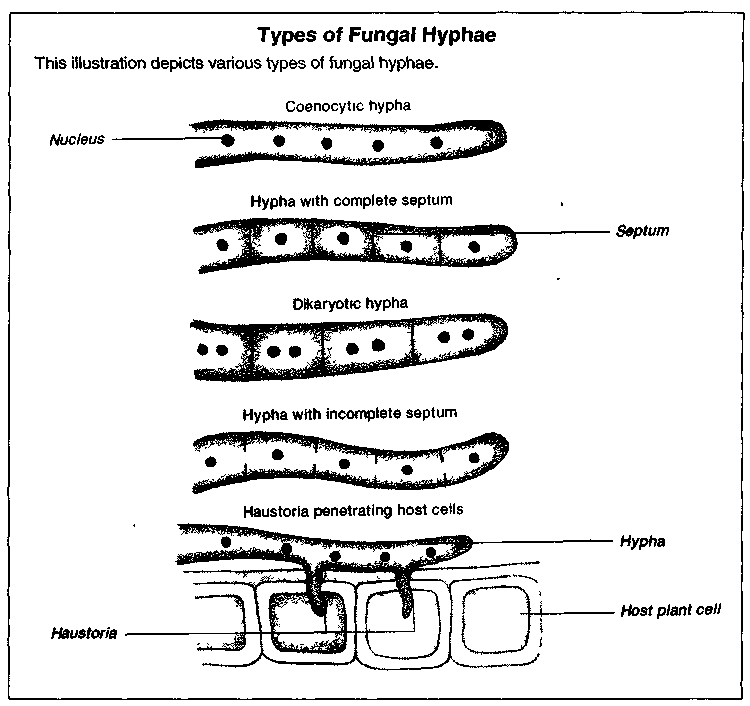
- •Kingdom Fungi Objectives
- •I. Fungal Structure, Nutrition, and Ecology
- •II. Reproduction
- •III. Taxonomic Classification
- •IV. Importance
- •Objectives
- •I. Introduction to the Plant Kingdom
- •Relatives Objectives
- •I. Vascular Plants
- •II. Nonseed Vascular Plants
- •III. Division Psilophyta (Whisk Ferns)
- •IV. Division Lycophyta (Club Mosses)
- •V. Division Sphenophyta (Horsetails and Scouring Rushes)
- •VI. Division Pterophyta (Ferns)
- •Objectives
- •I. Seed Vascular Plants
- •II. Division Coniferophyta (Conifers)
- •III. Other Gymnosperms
- •IV. Human and Ecologic Importance
- •Objectives
- •I. Flowering Plants
- •II. Monocotyledons and Dicotyledons
- •III. Evolutionary Trends
Kingdom Fungi Objectives
After studying this chapter, the reader should be able to:
Describe the major features of the kingdom Fungi and its three subkingdoms.
List distinguishing characteristics for each major group of fungi.
Trace the life cycles of representative fungi.
Describe the ecologic and economic importance of fungi.
Discuss the mutualistic relationships formed by lichens and mycorrhizae.
I. Fungal Structure, Nutrition, and Ecology
A. General information
1. Fungi historically have been classified with plants, but major differences between
these organisms necessitated the formation of a separate kingdom
Fungi are eukaryotic, usually multicellular, multinucleate organisms
They obtain nutrients by secreting enzymes into their substrate and absorbing
the digested materials
Most fungal cell walls contain the polysaccharide chitin
The fungal structure is characterized by long slender filaments called hyphae
(see Types of Fungal Hyphae for an illustration)
a. Coenocytic hyphae consist of long cellular strands with many nuclei, which
are not contained within individual cells
b. Hyphae with complete septa (barriers) are separated into individual cells;
septate hyphae may contain a single nucleus in each cell or two nuclei in each cell (called dikaryotic hyphae)
c. Hyphae with incomplete septa allow cytoplasm to flow freely from cell to cell
d. Some parasitic fungi have haustoria, which are specialized hyphae that ex-
tend into individual host cells
6. The mycelium is the mass of hyphae that constitutes the body of a fungus; it is
the most recognizable structure of a mushroom (toadstool)
B. Modes of nutrition and metabolism
Fungi (along with bacteria) are the principal decomposers in every ecosystem
They can break down lignin, a major component of wood
Some fungi also attack living organic matter, causing agricultural damage and de-
stroying food stores; food contaminated by fungi may be unpalatable or poisonous to humans

4. Warm, moist, dark conditions are most favorable for fungal growth; however, fungi
can grow in various other habitats
5. If conditions become too stressful, fungi survive by producing spores, which are
resistant to temperature and moisture extremes
6. Parasitic fungi use haustoria to penetrate individual host cells and absorb nutri-
ents directly from the cytoplasm
C. Ecology
Fungi typically form symbiotic relationships with plants or algae
Two types of fungal symbionts are lichens and mycorrhizae
Lichens are a combination of fungi (Ascomycetes or Basidiomycetes) and green
algae (phylum Chlorophyta) or cyanobacteria (kingdom Monera) a. The algae portion of the lichen provides food through photosynthesis; the fungal portion acts as a living sponge to improve water retention
(1) Some evidence suggests that the fungal partner parasitizes the algae
in a controlled fashion and sometimes may even destroy algal cells
(2) The fungal component of lichens rarely grows independently, although
the algal component may do so
b. Lichens inhabit cold, dry, and generally harsh environments, where they help
break rock surfaces and prepare the habitat for other organisms
c. They survive harsh or adverse conditions by becoming dehydrated, which
subsequently slows their metabolism
(1) When the lichen's water content drops dramatically, the upper portion
of the thallus becomes opaque enough to exclude light from the photo-synthetic algae
(2) Dehydrated lichen are unaffected by most environmental extremes be-
cause they are temporarily dormant and do not engage in photosynthesis
d. Lichens absorb nutrients from rain and air; for this reason, they are very sen-
sitive to air quality and are among the first organisms to perish in a polluted environment
e. Lichens are grouped into three major growth forms
(1) Crustose lichens attach to or embed in their substrate and often form
brightly colored, crusty patches on bare rocks and tree bark
(2) Foliose lichens have leaflike thalli, are weakly attached to their sub-
strate, and have edges that are crinkly or divided into lobes
(3) Fruticose lichens resemble miniature upright shrubs or may hang from
tree branches; their thalli are usually branched and cylindrical 4. Mycorrhlzae are a combination of fungi and plant roots
a. Mycorrhizae enhance the absorption of essential nutrients by plant roots
(1) They also may provide protection against the effects of acidic soil and
may make a plant more resistant to drought, cold, and harsh conditions
They can prevent the accumulation of toxic metals in plants
They can help plants to grow better in poor soils
They can speed the seed germination of orchids
b. About 90% of all plants have a symbiotic relationship with mycorrhizae
c. Plants with mycorrhizae develop fewer root hairs than those without mycorrhi-
zae; the mycorrhizae perform the same functions as root hairs, making them less necessary
d. Mycorrhizae are highly susceptible to acid rain, which may negatively affect
the growth of some plants
e. The two forms of mycorrhizae are endomycorrhizae and ectomycorrhizae
(1) Endomycorrhizae, the more common variety, are characteristic of
many crop species and develop when the fungal hyphae penetrate the outer root cells
(2) Ectomycorrhizae, the less common variety, are characteristic of shrubs
and trees and develop when the hyphae surround, rather than penetrate, the root cells
